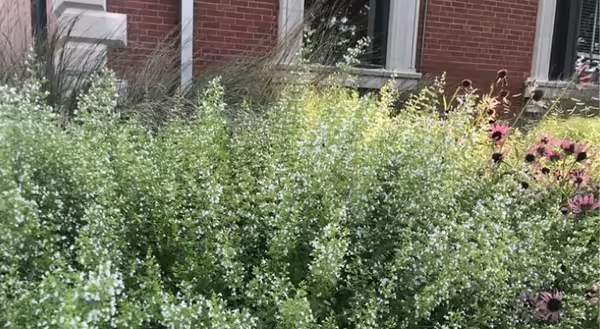
Sun-loving, season-long blooming, low maintenance, dependable and pollinator-friendly. Sound like a perfect perennial to add to your garden?
Calamint (Calamintha nepeta ssp. nepeta), selected as the Perennial Plant Association’s 2021 plant of the year, is a garden-favorite of many gardeners. The association votes to showcase a low-maintenance plant with multi-season interest, that’s relatively pest-free, and can be grown in a wide range of climates.
Native to Europe and the Mediterranean region, and a member of the mint family, calamint thrives in sunny locations but will also tolerate partial shade. Once the plant is established in the garden, it can be drought-tolerant with very few pests or disease problems.
Tiny white-to-lavender flowers covering foot-long spikes will bloom from early summer, all the way through the growing season, until frost. The gray-green foliage produces a pleasant herbal fragrance when crushed. Plus, fragrant foliage is resistant to deer and rabbits! This prolific bloomer is a perfect plant for pollinators too. Bees, butterflies, and other pollinators can often be found buzzing around calamint all summer, stopping for a tasty treat.
Calamint’s low-mounding and bushy growth habit grows two feet tall and wide; it’s perfect for the front of a border garden, in container gardens, or even a rock garden. In the landscape, interplant calamint with ornamental grasses, like switchgrass (Panicum virgatum), and prairie dropseed (Sporobolus heterolepis). Or go for a monochromatic theme, planting other white flowers, such as ‘Galaxy White’ Lily of the Nile (Agapanthus sp.) and white coneflowers (Echinacea). Combine other great pollinator plants, like salvia (Salvia sp.), lavender (Lavandula), and anise hyssop (Agastache) to create a pollinator paradise.
Calamint can spread in the garden by rhizomes, or can easily self-seeds to form a dense ground cover. To keep the plant looking tidy, cut the plant back 8-10”, removing the spent flower spikes. This will also prevent the plant from self-seeding and spreading throughout the garden. Calamint can be divided in the early spring or fall. Dig up all or a portion of the plant, separate the rhizomes, making sure each section has a healthy root system, and replant in the desired location, or share with a friend (note: if you suspect Jumping Worms in your garden, avoid sharing divided perennials).
Past Perennial Plant Association Plants of the Year to also consider planting in your garden are Japanese spikenard (Aralia cordata 'Sun King'), betony (Stachys monieri 'Hummelo'), ornamental onion (Allium 'Millenium'), and butterfly weed (Asclepias tuberosa).
ABOUT THE AUTHOR: Brittnay Haag is a Horticulture Educator with University of Illinois Extension, serving Livingston, McLean, and Woodford Counties. Her work focuses on youth horticulture education, specifically through school gardens and Jr. Master Gardener programs. Brittnay provides leadership for three county Master Gardener programs, and is responsible for developing community programs and providing expertise in horticulture and environmental sciences.